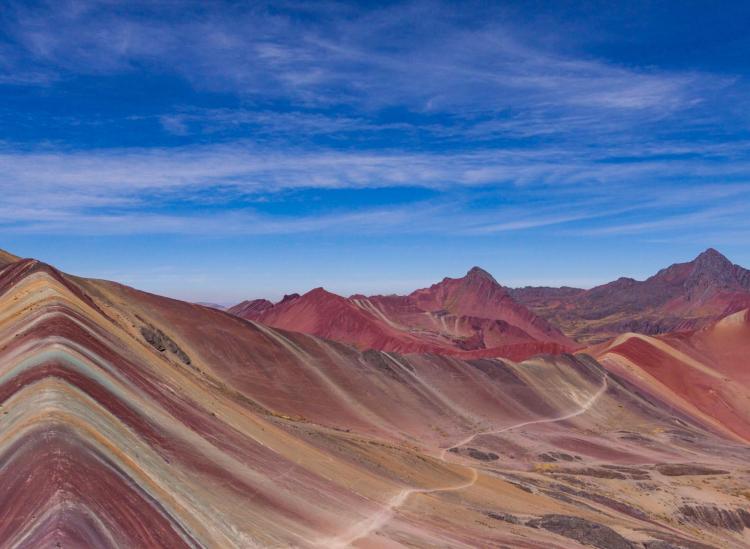Your Guide To The Different “Rainbow” Mountains Around The World

Unsplash/Roi Dimor
While rainbow foods have been trending for the past couple years, nature-made rainbows are blowing up in the travel world. But several of these “rainbow” mountains around the world look pretty similar. Here’s how to tell them apart when you see them appear in your Instagram feed and what you should know about potentially booking your own trip to see them.
Vinicunca, Peru
Layers of sediment and crashing tectonic plates created this geometric spectacle in the Andes Mountains. It’s 16,000 feet above sea level and a popular stop for travelers hiking in Peru. It’s just a few hours from Macchu Picchu, located in an alpine region populated by alpaca herders. And Vinicunca Rainbow Mountain is truly unique, you won’t find the symmetrical colors anywhere else in the world.
However, tourists should be aware that on an average day, the mountain won’t look as bright as it does on Instagram. It’s still a cool landscape, but the ultra-bright colors you see on the ‘gram are a mixture of sunny days and photo filters.
And there’s another downside. The increased foot traffic of tourists is literally degrading the trails leading to the best views. So if you do go, make sure to stay on assigned trails to make sure the landscape stays intact and rainbowy for the travelers who visit after you.
Zhangye Danxia Landform Geological Park, China
Sandstone and mineral rock were pressed together over 24 million years, creating this amazing mountain range in northwest China. It’s a UNESCO World Heritage Site near Zhangye, in the Gansu Province, where you can connect by train from larger Chinese cities. The best time to visit is June to September and you’ll see cooler colors early in the morning or around sunset.
You’ll see a wider range of colors here, with different minerals tinting rocks red, yellow, green and blue. The stripes come from the million-year process of scrambling the different layers of differently oxidized rock. But still, don’t be fooled by oversaturated Instagrams. The range isn’t a literal rainbow. The hues appear because of a mix of light and pushing the saturation levels all the way up in your favorite photo-editing app.
Vermilion Cliffs National Monument, Arizona, U.S.
We have our own rainbow rocks in the U.S., spanning 30,000 acres in Arizona near the Utah border. The most famous formation here is the Wave, but since permits can be a struggle to get, you can see the wavy rock formations in other areas as well. You’ll still need a permit for Coyote Butte, but the competition isn’t as steep as for the Wave. You can get them in person at Grand Staircase-Escalante National Monument Visitor Center in Kanab, Utah.
High season is summertime, but bear in mind that the desert gets extremely hot in Arizona in July. It’s better to go April to June or September to October.
RELATED
These Beginner Hikes Around The Country Are Easy, But Far From Boring
Here’s Everything You Need To Know About Instagram’s Favorite Canyon
10 Long Distance Hikes With No Camping Involved











